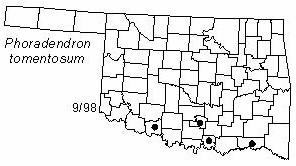Shrublike evergreen plant, parasitic on several species of broadleaf trees. The plants are attached to and penetrate the branches of host trees and form bushy growths up to 1 m (3 ft) in diameter. Stems brittle, much-branched, usually stellate-pubescent. Leaves opposite, entire, succulent, yellow-green, usually obovate, 2-6 cm (0.8-2.4 in) long and 1.5-2 cm (0.6-0.8 in) wide. Staminate inflorescence 2-3.5 cm (0.8-1.4 in) long, divided into 3-6 segments, with numerous very small yellowish flowers. Pistillate inflorescence 1.5-3.5 cm (0.6-1.4 in) long, divided into 3-5 segments each with 4-11 very small yellowish flowers. Fruits globose, white, 4-6 mm (0.15-0.25 in) in diameter, with sticky pulp, ripening in early Winter and remaining attached for several months.
Distribution: Native from Southcentral Oklahoma to southwestern Texas and Mexico.
Habitat: Deciduous trees, mostly Prosopis and Celtis.
NWI status: none
Comment: The plant is often used for Christmas decorations. The berries are said to be poisonous, but birds eat them. Phoradendron is derived from Greek words meaning "thief" and "tree", and refers to its parasitic habit; tomentosum refers to the hairy stems.
Distribution in Oklahoma: 
BACK
NEXT
RETURN TO INDEX
Last update: 9/15/99
 Go to Oklahoma Biological Survey Home Page
Go to Oklahoma Biological Survey Home Page
 Disclaimer
Disclaimer